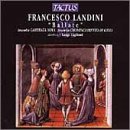| All Artists: Francesco Landini Title: Ballate Members Wishing: 1 Total Copies: 0 Label: Tactus Records Release Date: 11/28/2000 Genres: Pop, Classical Styles: Vocal Pop, Opera & Classical Vocal, Historical Periods, Early Music Number of Discs: 1 SwapaCD Credits: 1 UPCs: 723723963925, 8007194101553 |
Search - Francesco Landini :: Ballate
 | Francesco Landini Ballate Genres: Pop, Classical
|
Larger Image |
CD Details |
CD ReviewsFrancesco Landini's Ballate C. Dalton | The New World | 01/21/2008 (5 out of 5 stars) "The polyphonic songs are very enjoyable and broken up by several instrumental arrangements that sound authentically Medieval without falling into kitsch territory. The recording is bright and clear without the 9 second reverb found in most recordings of music from this time. The only drawback: no English translations for the songs!" Beautiful late medieval music Kimberly L. Stewart | longmont, co United States | 10/20/2007 (5 out of 5 stars) "I'm not exactly an early-music expert, but I have about 20-30 rennaisance/medieval CDs and this is one of my favorites. Landini's music has that wonderful medieval sound, not quite as ethereal as high-rennaisance music or Gregorian chant, but with a little more recognizable melody and rhythm. The pieces are 3-part vocal secular music - basically love songs, as opposed to "heavy art/religious music". This disc contains some musical accompaniment (for instance, when the written music only has words for two of the three melody lines) which adds some color compared to many acappella eary music recordings. The simple (compared to later renaissance music) harmonies of the voices give a wonderful medieval atmosphere. Overall, a wonderful CD for pleasant background music, but lively and interesting enough to capture the attention of a lover of medieval music." A Lost Archipelago of Music Giordano Bruno | Wherever I am, I am. | 10/07/2009 (5 out of 5 stars) "Almost the whole surviving repertoire of "trecento" North Italian polyphony is found in one exquisite hand-lettered and illuminated manuscript, the Squarcialupi Codex, prepared as a retrospective by the Florentines at the very moment when their finest local musical manner was being eclipsed by the immigrant fashions of Flemish polyphony. The local boy of greatest fame was the blind organist Francesco Landini. Don't imagine a modern organ, please! Landini played a 'portative' organ, pumping his own bellows with one hand; he's pictured doing so in the Codex. Trecento polyphony was chiefly a secular phenomenon, an evolved version of "ars nova" and late troubadour styles, with its own specific notation and its own flamboyant flaunting rhythmic complexities. The novelty and excitement of this music is principally rhythmic, probably fueled by the development of a notational system capable of recording such polyrhythmic irregularity. All the music in the Squarcialupi Codex is texted, but instruments ceratinly flourished among the Florentines; besides the portative organ, there were small lutes strummed with plectrum, other plucked strings, harp, hand percussion, and the "vielle", the Medieval fiddle from which all fiddles derive. You'll hear all these played effectively by the ensemble Chominciamento di Gioia on this CD. The vocal ensemble has another name - Camerata Nova - and includes soprano, alto, and tenor singers.
There are very few worthy recordings of Trecento music, or of ars nova in general. The very best of the crop are those by the American ensemble PAN (Project Ars Nova). This recording falls a little short of PAN's technical proficiency, but it has the taste of the real thing. Think about the clothes those Florentines wore! Some are pictured in a round dance on the cover of this CD. You can be sure their music was not sedate, dry, or effete. They were a lusty bunch, and a performance of their music should convey their passionate spirit. "Chominciamento di Gioia" means "The Beginning of Joy". I believe that's what they felt, in their flowering city-state at the threshold of the Renaissance." |

 Track Listings (18) - Disc #1
Track Listings (18) - Disc #1